The Most Extensible AFM Solution
Supports Park’s most extensive range of SPM modes and options in the industry
Today's researchers need to characterize a wide range of physical properties under diverse measurement conditions and sample environments. Park Systems provides the most extensive range of SPM modes, the largest number of AFM options, and the best option compatibility and upgradeability in the industry for advanced sample characterization.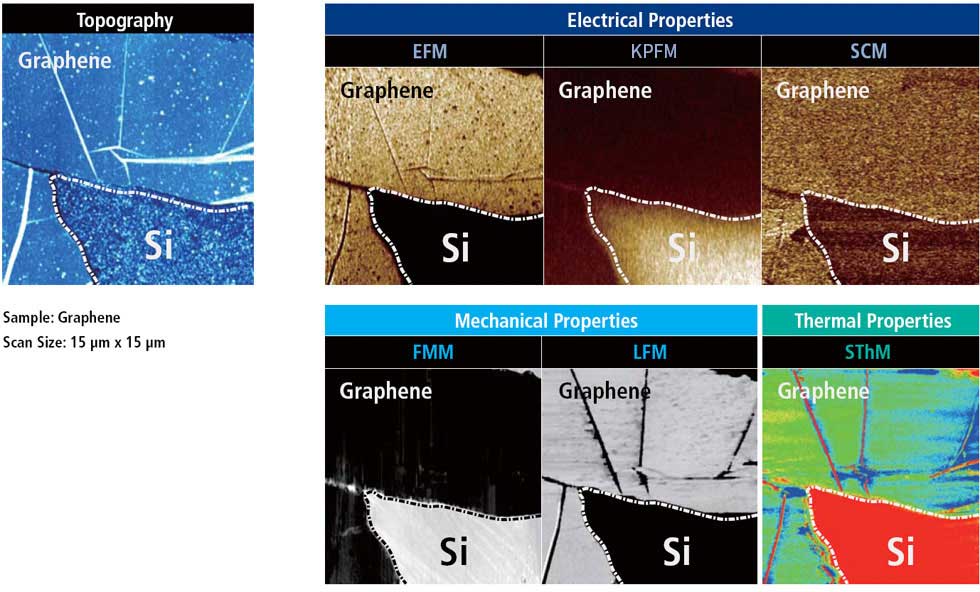
Park XE7 has the most extensive range of SPM modes (*Optionally available)
Standard Imaging
Chemical Properties*
Force Measurement
Electrical Properties*
- Conductive AFM
- IV Spectroscopy
- Kelvin Probe Force Microscopy (KPFM)
- Scanning Capacitance Microscopy (SCM)
- Scanning Spreading-Resistance Microscopy (SSRM)
- Scanning Tunneling Microscopy (STM)
- Photo Current Mapping (PCM)
Magnetic Properties*
Dielectric/Piezoelectric Properties*
Mechanical Properties*
Thermal Properties*
Park XE7 Specifications
Scanner
Z Scanner
Guided high-force flexure scanner
Scan range : 25 µm
Height noise level : 50 pm
(RMS, at 0.5 kHz bandwidth)
XY Scanner
Single module flexure XY-scanner with closed-loop control
Scan range : 50 µm × 50 µm
(optional 10 µm × 10 µm or 100 µm × 100 µm)
Stage
Z travel range : 29.5 mm (Motorized)
Focus travel range : 70 mm (Manual)
XY travel range : 13mm × 13 mm (Manual)
Sample Mount
Sample size : Open space up to 100 mm x 100 mm, thickness up to 20 mm
Sample weight : < 500g
Optics
Coupled with 10x (0.28 N.A.) objective lens
Direct on-axis vision of sample surface and cantilever
Field-of-view : 480 × 360 µm (with 10× objective lens)
CCD : 1 M pixel, 5 M pixel (optional)
Software
SmartScan
Dedicated system control and data acquisition software
Adjusting feedback parameters in real time
Script-level control through external programs (optional)
XEI
AFM data analysis software
Electronics
High performance DSP : 600 MHz with 4800 MIPS
Maximum 16 data images
Maximum data size : 4096 × 4096 pixels
Signal inputs : 20 channels of 16 bit ADC at 500 kHz samplings
Signal outputs : 21 channels of 16 bit DAC at 500 kHz settling
Synchronous signal : End-of-image, end-of-line, and end-of-pixel TTL signals
Active Q control (optional)
Cantilever spring constant calibration (optional)
CE Compliant
Power : 120 W
Signal Access Module (Optional)
AFM Modes
(*Optionally available)
Standard Imaging
True Non-Contact AFM
Basic Contact AFM
Lateral Force Microscopy (LFM)
Phase Imaging
Tapping AFM
Force Measurement
Force Distance (F/d) Spectroscopy
Force Volume Imaging
Dielectric/Piezoelectric Properties*
Mechanical Properties*
Force Modulation Microscopy (FMM)
Nanoindentation*
Nanolithography*
Nanolithography with High Voltage*
Nanomanipulation*
Magnetic Properties*
Magnetic Force Microscopy (MFM)
Tunable Magnetic Field MFM
Electrical Properties*
Conductive AFM (C-AFM)
IV Spectroscopy
Kelvin Probe Force Microscopy (KPFM)
KPFM with High Voltage
Scanning Capacitance Microscopy (SCM)
Scanning Spreading-Resistance Microscopy (SSRM)
Scanning Tunneling Microscopy (STM)
Photo Current Mapping (PCM)
Chemical Properties*
Chemical Force Microscopy with Functionalized Tip
Electrochemical Microscopy (EC-AFM)
AFM Options
Temperature Control
Temperature Controlled Stage 1
-25 °C to +170 °C
Temperature Controlled Stage 2
Ambient to +250 °C
Temperature Controlled Stage 3
Ambient to +600 °C
Liquid Cells
Universal Liquid Cell
Open or closed liquid cell with liquid/gas perfusion
Temperature control range: 0 °C to +110 °C (in air), 4 °C to +70 °C (with liquid)
Electrochemistry Cell
Open Liquid Cell
Liquid Probehand
Designed for imaging in general liquid environment
Resistant to most buffer solutions including acid
Contact and Non-contact AFM imaging in liquid
Magnetic Field Generator
Applies external magnetic field parallel to sample surface
Tunable magnetic field
Range : -300 ~ 300 gauss
Composed of pure iron core & two solenoid coils
Dimensions in mm
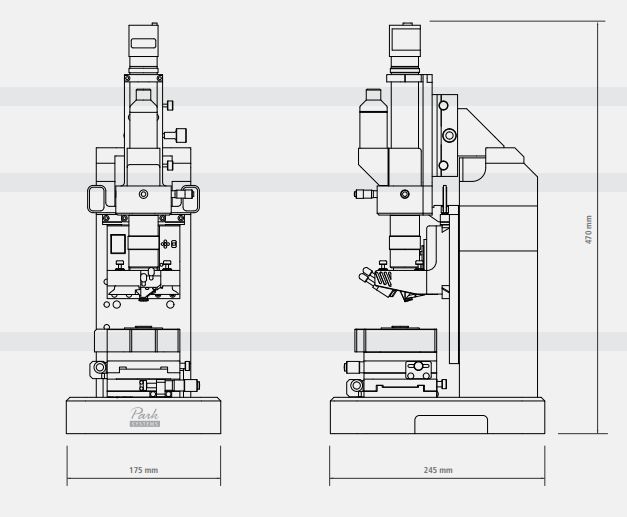
Accurate XY Scan by Crosstalk Elimination
XE scan system
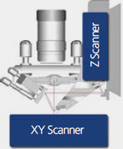
- independent, loop XY and Z flexure scanners for sample and probe tip
XY flexure scanner
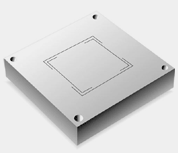
- Flat and orthogonal XY scan with low residual bow
XE-Peformence
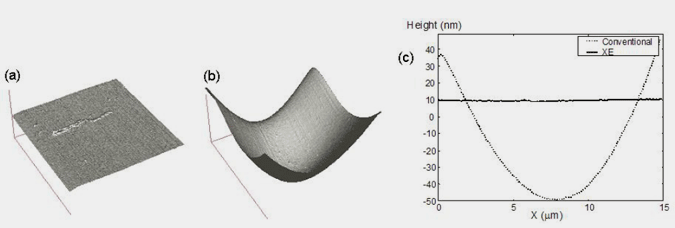
Figure 9. Zero background curvature by Park Systems XE-system (a) and typical background curvature of a conventional AFM system with a tube scanner (b). (c) shows the cross section of these background curvatures.
Figure 9. shows unprocessed AFM images of a bare silicon wafer taken with the XE-system (a), and with a conventional AFM (b). Since the silicon wafer is atomically flat, most of the curvatures in the image are scanner-induced artifacts. Figure 9. (c) shows the cross section of the images in Figure 9. (a) and (b). Since the tube scanner has intrinsic background curvatures, the maximum out-of-plane motion is as much as 80 nm when the X-axis moves 15 μm. The XE scan system has less than 1nm of out-of-plane motion for the same scan range. Another advantage of the XE scan system is its Z-servo response.
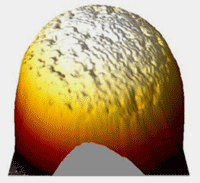
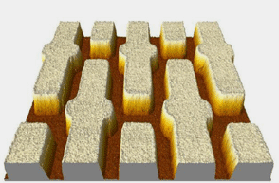
Figure 10. Figure 11.
Figure 10. is an image of a porous polymer sphere (Styrene Divinyl Benzene), whose diameter is about 5 µm, taken with the XE-system in Non-Contact mode. Since the Z-servo response of the XE-system is very accurate, the probe can precisely follow the steep curvature of the polymer sphere as well as small porous surface structures without crashing or sticking to the surface. Figure 11. shows another example that demonstrates the high performance of the z-servo response with a flat background.
Best Life, by True Non-Contact™ Mode
True Non-Contact™ Mode

- Less tip wear = Prolonged high-resolution scan
- Non-destructive tip-sample interaction = Minimized sample modification
- Immunity from parameter dependent results
Tapping Imaging
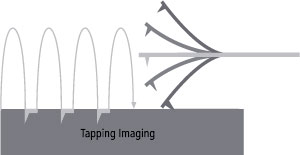
- Quick tip wear = Blurred low-resolution scan
- Destructive tip-sample interaction = Sample damage and modification
- Highly parameter-dependent
Longer Tip Life and Less Sample Damage
The sharp end of an AFM tip is so brittle that once it touches a sample, it becomes instantly blunt and limits the resolution of an AFM and reduces the quality of the image. For softer samples, the tip will damage the sample and also result in inaccuracies of sample height measurements. Consequently, preserving tip integrity enables consistent high resolution and accurate data. True Non-Contact Mode of the XE-AFM superbly preserves the tip, resulting in a much longer tip life and less sample damage. The figure, displayed in 1:1 aspect ratio, shows the unprocessed raw data image of a shallow trench isolation sample imaged by the XE-AFM, whose depth is also confirmed by scanning electron microscope (SEM). The same tip used in the imaging of the sample shows no tip wear even after taking 20 images.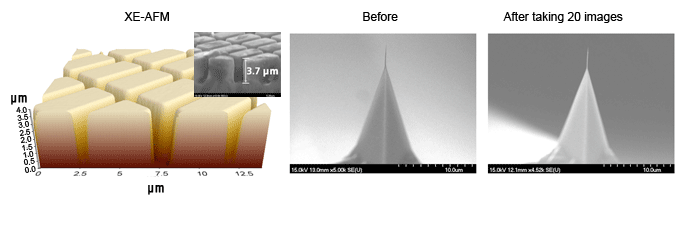
Park XE7 features
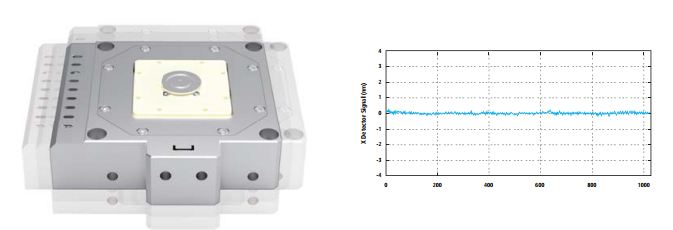 The XY scanner consists of symmetrical 2-dimensional flexure and high-force piezoelectric stacks provides high orthogonal movement with minimal out-of-plane motion as well as high responsiveness essential for precise sample scanning in the nanometer scale. The compact and rigid structure was designed for low noise, high speed servo response.
The XY scanner consists of symmetrical 2-dimensional flexure and high-force piezoelectric stacks provides high orthogonal movement with minimal out-of-plane motion as well as high responsiveness essential for precise sample scanning in the nanometer scale. The compact and rigid structure was designed for low noise, high speed servo response.
Driven by a high-force piezoelectric stack and guided by a flexure structure, its rigidity allows it to move at higher speeds in the vertical direction than the scanners used in conventional AFMs. The maximum Z scan range can be extended from 12 µm to 25 µm with the optional long range Z scanner (optional).
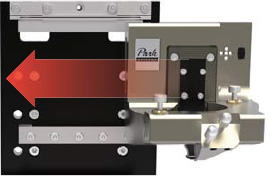
The AFM head is easily inserted or removed by sliding it along a dovetail rail. The low coherency of the Super Luminescence Diode (SLD) enables accurate imaging of highly reflective surfaces and precise measurements for pico-Newton Force-distance spectroscopy. The SLD wavelength eliminates interference issues for users interested in combining the AFM with experiments in the visible spectrum.
The unique head design can handle up to 100 mm sample size and allows for easy side access to the sample and tip.
The measurement location of the sample is easily and precisely controlled by the manual XY stage. The travel range of the XY sample stage is 13 mm x 13 mm.
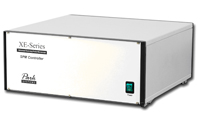
The nanoscale signals from the AFM are controlled and processed by the high performance Park XE electronics. With its low noise design and high speed processing unit, Park XE electronics successfully realize True Non-Contact™ mode ideal for nanoscale imaging as well as precise voltage and current measurement.
• High performance processing unit of 600 MHz and 4800 MIPS speed
• Low noise design for precise voltage and current measurement
• Versatile system to utilize various SPM techniques
• External Signal Access Module to access AFM input/output signals
• Maximum 16 data images
• Maximum data size: 4096 × 4096 pixels
• ADC/DAC in 16 bit, 500 kHz speed
• Electric noise isolation from PC by TCP/IP connection




